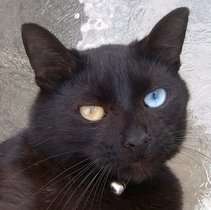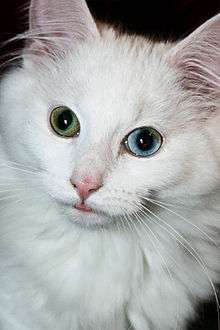Odd-eyed cat

An odd-eyed cat is a cat with one blue eye and one eye either green, yellow, or brown. This is a feline form of complete heterochromia,[1][2] a condition that occurs in some other animals. The condition most commonly affects white-colored cats, but may be found in a cat of any color, provided that it possesses the white spotting gene.[3]
Cause

The odd-eyed coloring is caused when either the epistatic (dominant) white gene (which masks any other color genes and turns a cat completely white)[4] or the white spotting gene (which is the gene responsible for bicolor and tuxedo cats)[5] prevents melanin (pigment) granules from reaching one eye during development,[3] resulting in a cat with one blue eye and one green, yellow, or brown eye. The condition only rarely occurs in cats that lack both the dominant white and the white spotting gene.[4]
Kittens

As with some newborn mammals, all cats are blue-eyed as kittens,[6] and may change as the newborn ages. The differences in an odd-eyed kitten's eye color might not be noticeable, save upon close inspection. Odd-eyed kittens have a different shade of blue in each eye. The color of the odd eye changes over a period of months–for example, from blue to green to yellow or from green to blue to yellow–until it reaches its final, adult color.
Cultural reactions and folklore
Odd-eyed cats are popular within several breeds, including Turkish Van, Turkish Angora, Sphynx, Persian, Oriental Shorthair, Japanese Bobtail and Khao Manee. In 1817, the government of Turkey, in conjunction with the Ankara Zoo, began a meticulous breeding program to preserve and protect pure white Turkish Angora cats with blue and amber eyes, a program that continues today, as they are considered a national treasure.[7][8] The zoo specifically prized the odd-eyed Angoras who had one blue eye and one amber eye, as the Turkish folklore suggests that "the eyes must be as green as the lake and as blue as the sky."[9][10] The mascot of the 2010 FIBA World Championship, hosted by Turkey, was an anthropomorphized odd-eyed Van Cat named "Bascat".[11]
Muhammad's pet Angora, Muezza, was reputed to be an odd-eyed cat.[10] In the Japanese Bobtail, odd-eyed cats are most frequently found in calico individuals.[12]
Deafness in odd-eyed cats

There is a common misconception that all odd-eyed cats are born deaf in one ear. This is not true, as about 60%–70% of odd-eyed cats can hear.[4] About 10%–20% of normal-eyed cats are born deaf or become deaf as part of the feline aging process.[4] White cats with one or two blue eyes do, however, have a higher incidence of genetic deafness, with the white gene occasionally causing the degeneration of the cochlea, beginning a few days after birth.[13] If a white kitten has any speck of another color, the frequency of deafness is greatly diminished, even if the speck of coloration fades as the cat becomes more mature.
Eyeshine and red-eye effect

In flash photographs, odd-eyed cats typically show a red-eye effect in the blue eye, but not in the other eye. This is due to the combined effect of the (normal) presence of a tapetum lucidum in both eyes and the absence of melanin in the blue eye. The tapetum lucidum produces eyeshine in both eyes, but in the non-blue eye a layer of melanin over the tapetum lucidum selectively removes some colors of light.
References
- ↑ Foster, Race and Smith, Marty, (DVMs), Heterochromia, A-Z Health Library, Purina-One. Retrieved February 2007.
- ↑ Foster, Race and Smith, Marty (DVMs), Heterochromia: Eye Color, Peteducation.com. Retrieved February 2007.
- 1 2 "White" Genetics Page, Norwegian Forest Cats, Furry Boots. Retrieved February 2007.
- 1 2 3 4 Hartwell, Sarah. White Cats, Eye Colours and Deafness, Messybeast.com. Retrieved February 2007.
- ↑ Hartwell, Sarah. Beautiful Bi-colours: Tuxedo and Magpie cats, Messybeast.com. Retrieved February 2007.
- ↑ Hints for Determining Cat Color, The Cat Fanciers Association, . Retrieved February 2007.
- ↑ Turkish Angora, Cats United International. Retrieved February 2007.
- ↑ Helgren, Anne. Turkish Angora, Iams. Retrieved February 2007.
- ↑ Hartwell, Sarah. Experimental & Unusual Cat Breeds - A, PetPeoplesPlace.com. Retrieved February 2007.
- 1 2 Turkish Angora Breeders, Breedersden.com. Retrieved February 2007.
- ↑ "2010 FIBA World Championship Event Guide: Mascot". FIBA. Retrieved 2010-09-12.
- ↑ Bruce Fogle, The New Encyclopedia of the Cat ISBN 0-7894-8021-2, "Longhair - Japanese Bobtail"
- ↑ Starbuck, Orcan and Thomas, David. Cat Color FAQS: Cat Color Genetics, CatFanciers.com. Retrieved February 2007
| Wikimedia Commons has media related to Odd-eyed cats. |